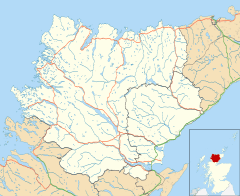Clachtoll facts for kids
Quick facts for kids Clachtoll
|
|
|---|---|
| OS grid reference | NC039269 |
| Council area | |
| Lieutenancy area | |
| Country | Scotland |
| Sovereign state | United Kingdom |
| Post town | Lairg |
| Postcode district | IV27 4 |
| Police | Northern |
| Fire | Highlands and Islands |
| Ambulance | Scottish |
| EU Parliament | Scotland |
Clachtoll (pronounced 'clach-TOLL') is a small, charming village located right on the coast in the northwest of Scotland. It's a place where people have traditionally fished and farmed small plots of land, known as crofting. You can find Clachtoll in the Highland Council area, near the beautiful Bay of Clachtoll. The nearest larger village for mail is Lairg, which is about 50 miles inland.
Contents
Discovering Clachtoll's History
Clachtoll is more than just a pretty village. It has a fascinating history, especially when you look at its name and the ancient ruins nearby. It's a great spot to explore Scotland's past and enjoy its stunning scenery.
What Does "Clachtoll" Mean?
The name Clachtoll comes from the old Scottish Gaelic language. It describes a special rock formation found on the headland close to the village. The word "clach" means "rock," and "toll" means "hole" or "cavity." So, Clachtoll means "rock with a hole." This name refers to a very large, broken rock that was once part of a natural arch.
Exploring the Ancient Clachtoll Broch
One of the most exciting discoveries in Clachtoll is an ancient building called a broch. A broch is a tall, round tower with double walls, built by people during the Iron Age. This particular broch stands right by the sea.
When Was the Broch Built?
Archaeologists, who are like history detectives, worked at the Clachtoll broch between 2017 and 2020. They found out that this impressive tower was probably built a very long time ago, between 400 and 250 BC. That's over 2,200 years ago!
What Happened to the Broch?
Even though the broch was once much taller, parts of its walls still stand up to 3 metres (about 10 feet) high today. The archaeologists also discovered that the broch was sadly burned down sometime between 50 BC and 25 AD. It's amazing to think about the people who lived in this strong tower so many centuries ago.


